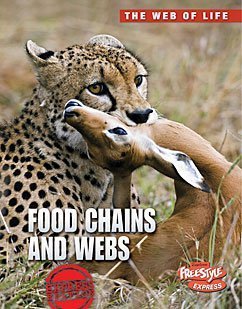Food Chains and Webs
By Andrew Solway
Raintree, 2012
ISBN #9781410944245
Grades 5-8
Nonfiction
“Living things need food to stay alive. That is simple and obvious. But if you start looking at what food different organisms need, and how they get it, it all gets complicated very fast.”
This book puts food chains and webs in the perspective of energy, making it an appropriate book for the upper elementary grades and middle school students. The book introduces food by making connections and includes a diagram of this overall concept.
From energy, the book goes on to trace the different groups of producers and consumers, filling in details on the range of concepts that accompany each topic. Sidebars, diagrams, and photos add additional information. For example, the producers are presented in the usual manner, but then it goes on to include phytoplankton and other unusual producers, taking the information to a higher level than the basic food web. The book illustrates specific examples of the text using photos and captions to further explain.
Vocabulary is bolded on the page and defined at the bottom of the page. The book makes the connection to people as humans and clears up or explains confusing terms or misconceptions about the vocabulary related to this topic.
Food Chains and Webs includes a case study of the Antarctic, a spread about the changes inflicted on organisms by people, and a conclusion. This is a fantastic book, filled with information for this aged reader, and certainly fills a most-needed niche for this topic.
Back matter includes a glossary, bibliography, websites, an index, and a list of three topics to research. This is a terrific book! It would have been in my middle school classroom when I taught.
Activity
Look up plant life and animals in an ecosystem. Using the information you read, list producers and consumers. Then create a food web of your own. Label the organisms with their names and place in the food chain. For the artistic, draw or find pictures of the organisms and add that to the food web.
Here’s a practice activity.
Information for younger readers
Use these organisms to create a prairie food chain.
Animals to use to create your own food web or chain.
Here’s a good explanation of food webs.
Book provided by publisher.








Shirley Smith Duke's Blog




